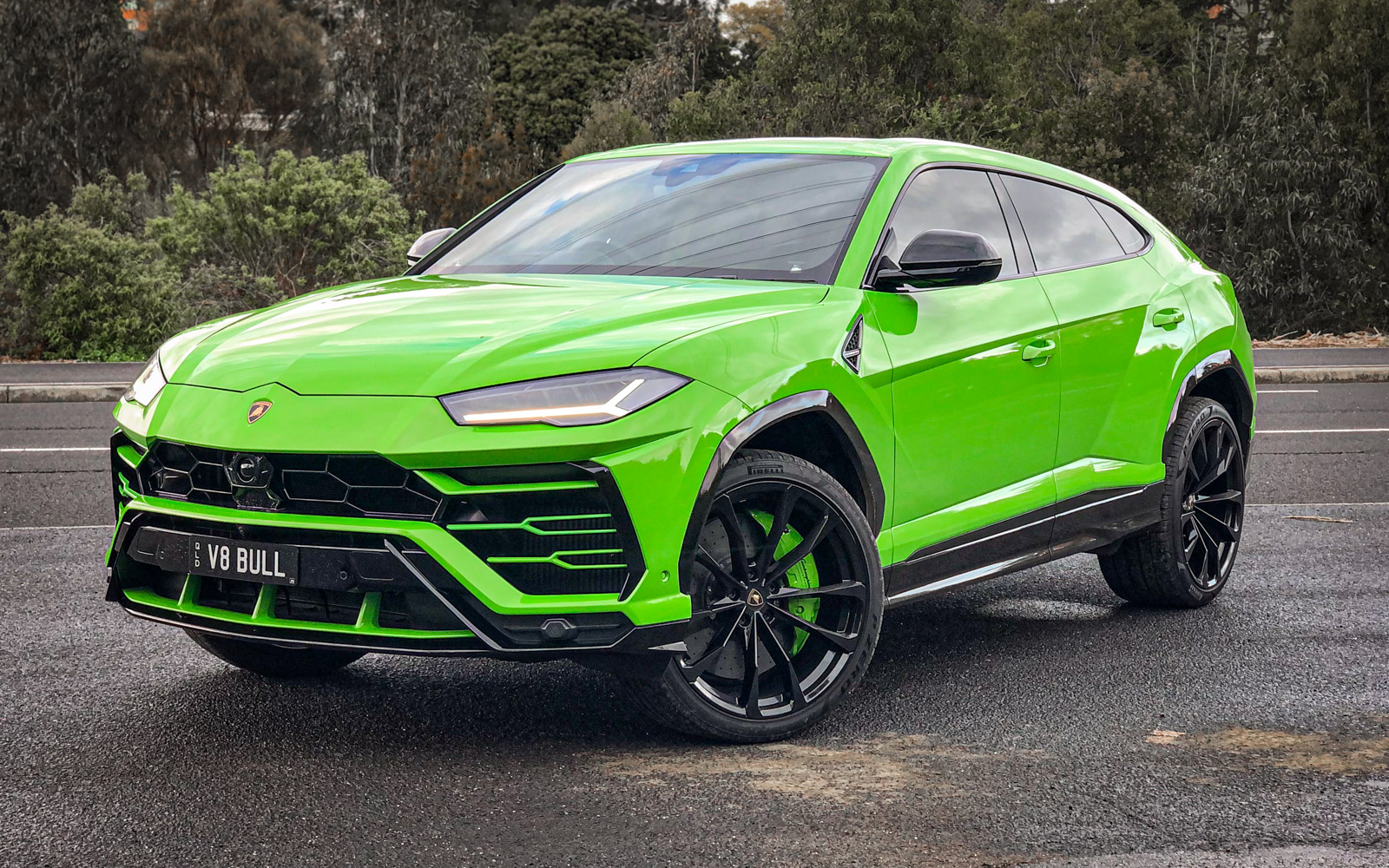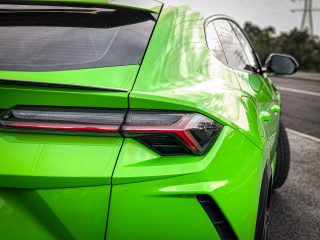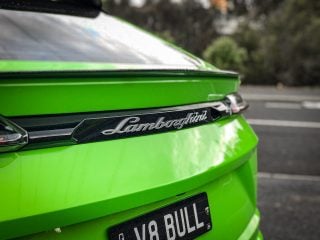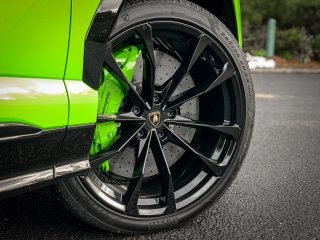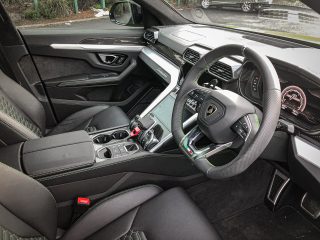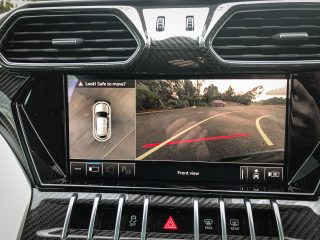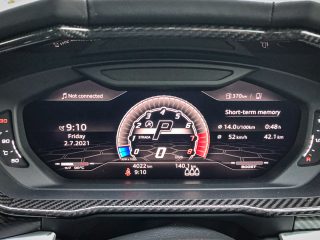You’ll be literally rocking the school gates when you pick up the kids in this untraditional Lamborghini on stilts.
It worked for Porsche, so why shouldn’t the Italians try it too? An SUV ‘supercar’ is what makers of fast, small cars need to do to keep (plenty) of money coming through the door. However, this is not Lamborghini’s first SUV – the boxy, often forgotten LM002 was the ultimate off-roader of the 1980s and 1990s.
The new Urus sits for sale alongside the company’s Huracan and Aventador models, but it has very different specs to those two. For starters, it’s front-engined, and it doesn’t have a V10 or V12, instead, it gets a twin-turbo V8 that is also found in two of the Urus’ closest rivals, the Porsche Cayenne Turbo and Bentley Bentayga.
Other rivals include the masterful Aston Martin DBX, the aggressive-looking Range Rover Sport SVR, along with the Audi SQ7 and Maserati Levante. Plenty to choose from, then. But there’s none quite like the Urus.
Controversial looks help the Urus to stand out, particularly in our tester’s bright green paint. Its mix of acute angles and sharp creases, high sides and small windows mean it certainly looks like no other SUV on the road. It has the performance to match the Lamborghini badge on the nose, though, as that engine is tuned to produce 478kW and 850Nm which gives the Urus a claimed 0-100km/h time of 3.6 seconds.
Like Lamborghini’s supercars, and ideal as it’s an SUV, there’s a four-wheel-drive transmission, while a ZF-sourced 8-speed automatic gearbox helps get that power to the tyres. This set-up is designed to deliver unbreakable traction on the road, rather than off-road ability, although air-suspension can raise the car to help it deliver that if needed.
There’s just one version of the Urus available at the moment, which has a price tag of $390,000 before on-road costs. Tick some options and it will approach $500k.
It’s unlikely you’ll be unmoved by any encounter with the Urus – even the Porsche Cayenne Turbo didn’t manage to be this divisive when the idea of an SUV with supercar handling was mooted. And it’s hard not to be impressed by how incredibly quick it is in a straight line and then around the corner. It is size-defying and is indeed as dramatic as a supercar on the road thanks to a monstrously powerful engine and seriously sophisticated suspension.
Leaving its phenomenally powerful V8 aside for a moment, the Urus’ platform with sophisticated 4×4 system is a good place to start. It’s sourced from the Audi SQ7, but the Lamborghini SUV boasts active anti-roll bars that eradicate any lateral wallowing in corners as well as rear wheel steering to help sharpen up turn-in responses. The driver can select drive modes with up to six settings using the Tamburo. That’s Lamborghini’s name for the array of controls on the centre console offering different chassis and powertrain presets for tarmac, sport and track driving, plus snow, gravel or sand.
The chassis tech all translates into a driving experience worthy of the Lamborghini name. Once you’re accustomed to the size of the beast, you can drive it as you would any modern performance car. Accurate and well-weighted steering offers crisp turn-in, and the Urus corners impressively flat and hard with tremendous grip. It’s also amazingly agile, offering quick responses to direction changes while remaining reassuringly stable.
It’s all surprisingly effortless from behind the wheel. The 8-speed automatic gearbox operates seamlessly in the background, while massive carbon-ceramic brakes bring the Urus to heel with dramatic efficiency on the road.
There is a price to pay for an SUV that handles like a sports car, however, and the ride is considerably firmer than the family might enjoy, with less than perfect tarmac transmitting some noise and vibration into the cabin.
However, you won’t be unimpressed one iota underneath the bonnet. Lamborghini has tweaked the Porsche Cayenne Turbo’s V8 for its installation here, hiking power to a monstrous 478kW and raising torque to an incredible 850Nm. The result is a 0-100km/h sprint of 3.6 seconds, and a claimed top speed of 305km/h – accompanied by a suitably threatening bellow from the exhaust when you’ve selected the sportier drive modes.
The Lamborghini Urus is a big beast, taking up more space on the road than its Porsche Cayenne stablemate, although the Urus is significantly lower thanks to styling designed to ape the exoticism of Lamborghini’s more usual fare.
In truth, the Urus is a little more conventional than most Lamborghinis. Yes, it shares the dramatic styling cues, powerful haunches and ‘look at me’ showiness, but you can forget about the exotic scissor doors of the flagship supercars. Indeed the black plastic wheelarch extensions and lower body mouldings give the Urus something of a mass-produced flavour, as does the five-door layout. The dramatic surface creases do their best to hide it, but the ubiquitous two-box format of the generic large SUV is hard to disguise.
The overall effect is undeniably different and certainly eye-catching – with plenty of the regulation Lamborghini wow factor. The sense of exotic styling continues inside with an Aventador-inspired dashboard and console. A highlight feature is the Tamburo controls at the base of the centre console, this cluster of buttons and dials is designed with an aviation theme. The rest of the interior is lavished with supple leather and Alcantara trim which gives the car a suitably rich and luxurious ambience with sporty rather than opulent overtones.
The feel-good factor is helped along by the array of latest infotainment technology that’s another significant dividend of VW Group ownership. Naturally, Lamborghini will encourage owners to express their own ‘bespoke’ styles through the Ad Personam scheme, which offers sufficient variety of colour and trim that Lamborghini says no two customer cars are ever likely to be identical.
As you’d expect in a $400k car from the VW Group, the Lamborghini Urus features some advanced infotainment kit including two big touchscreens, full connectivity and an optional Bang & Olufsen 1700 Watt audio system.
There’s plenty of room in the Lamborghini’s front seats, but the sloping, low-roofed body extracts a price in the back where both headroom and legroom for six-footers is in short supply. Additionally, the narrow window glass and relatively low seating position can make the rear seats feel a little claustrophobic – that’s quite at odds with the light and airy feel of many luxury SUV rivals.
You sit lower in the Urus than in most SUVs, and while this fits the Lamborghini’s sporting feel it does mean visibility is not as good. It can be hard to place the car in town or tight parking spaces, although it’s less of an issue on the open road.
Folding the rear seats down liberates a load space of 1596 litres, and even with the kids in the back you get 616 litres of boot volume. It’s definitely enough to make the Urus a practical – if expensive – option as daily transport.
However expensive the Urus is though, it does not have any true rival. Yes, there are the Cayennes and the Stelvios and the DBXs of the SUV world but there is nothing quite like the Urus. For what you do pay you do get back in terms of an authentic Lambrghini experience; boatloads of performance, a screaming personality, and, ultimately, enough practicality that it lives up to being an SUV too.




